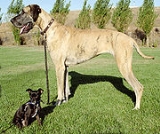
Artificial selection
Overview
Selective breeding
Selective breeding is the process of breeding plants and animals for particular genetic traits. Typically, strains that are selectively bred are domesticated, and the breeding is sometimes done by a professional breeder. Bred animals are known as breeds, while bred plants are known as varieties,...
) describes intentional breeding for certain traits, or combination of traits. The term was utilized by Charles Darwin
Charles Darwin
Charles Robert Darwin FRS was an English naturalist. He established that all species of life have descended over time from common ancestry, and proposed the scientific theory that this branching pattern of evolution resulted from a process that he called natural selection.He published his theory...
in contrast to natural selection
Natural selection
Natural selection is the nonrandom process by which biologic traits become either more or less common in a population as a function of differential reproduction of their bearers. It is a key mechanism of evolution....
, in which the differential reproduction of organisms with certain traits is attributed to improved survival or reproductive ability (“Darwinian fitness”). As opposed to artificial selection, in which humans favor specific traits, in natural selection the environment acts as a sieve through which only certain variations can pass.
The deliberate exploitation of artificial selection has become very common in experimental biology, as well as the discovery and invention of new drugs.
Artificial selection can also be unintentional; it is thought that domestication of crops by early humans was largely unintentional.
Artificial selection was practiced by the Romans
Ancient Rome
Ancient Rome was a thriving civilization that grew on the Italian Peninsula as early as the 8th century BC. Located along the Mediterranean Sea and centered on the city of Rome, it expanded to one of the largest empires in the ancient world....
.
Unanswered Questions
Discussions

